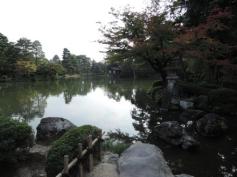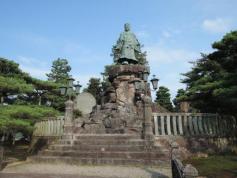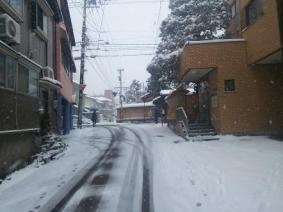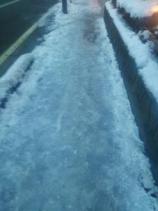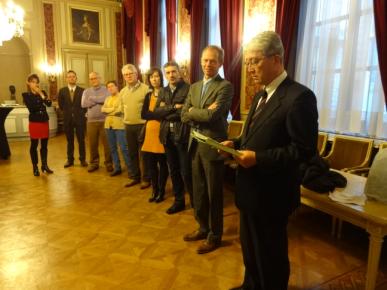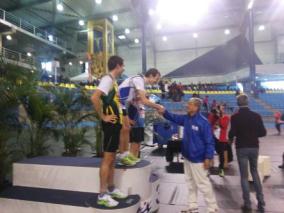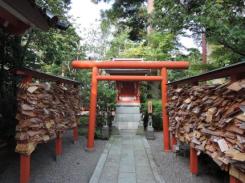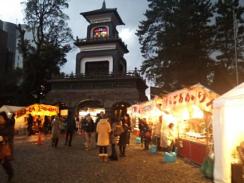JET Program CIR Report
CIR Report from Kanazawa 2
March 2014By Werner Vanhorenbeeck
(Coordinator for International Relations)
A Japanese friend from Europe visited me shortly after I wrote my last report. We went for a walk through the old chaya tea-house districts after we visited Kenroku-en garden, where a friendly shop owner told us that the garden will be lit up in the evening. The man was about to close his shop, so he offered to drive us back to the garden. I’ve been to the garden many times since my arrival in Kanazawa last August, but I never thought I’d go there twice in one day. I didn’t regret going, it was absolutely astonishing.
People warned me about how cold the winters in the Hokuriku region can be. Winter eventually came, and so did the snow. The outside temperatures weren’t as bad as I feared. It was actually quite a mild winter. There wasn’t that much snow either, but it came in waves. One day it snowed to be melted the next day, for the next day to snow on again. Like many westerners, I am used to trucks throwing salt to clear the roads during winter. It’s a bit different here in Kanazawa. Most roads over here have lines of sprinklers down the streets to melt the snow. I assume melting down snow with water is better for the asphalt than salt. Unfortunately it has some side-effects, such as a lot of water piling up on the sides of the roads, and the pavement being covered with ice. I thought it was a real challenge to walk to work without slipping on the ice covered pavement, not getting wet by walking on the road or by not getting sprinkled at. For this reason I decided to take the bus to go to work during the snowy months.
Houses in Japan are different from Belgian ones in many ways. It feels like Japanese houses are built for summer. They are cool, well ventilated and thus they don’t have much isolation, which can be pretty cold during winter. Of course there are many ways to keep warm, such as little packets filled with iron called ‘hokkairo’, which heat up once they come in contact with oxygen. They can be put in shoes or even attached to one’s back. My favourite thing during winter are the heated tables called ‘kotatsu’. It is basically a table with an attached heater and a cloth to prevent the heat from getting out. These kotatsu-tables are the perfect place to gather around with friends or family. In my case, I had a lot of fun playing video or board games with friends by the kotatsu on winter nights. Both these warming packets and heated tables have been around for a long time. The warming packets have been around since the early 1900s after an inventor named Niichi Matoba got the idea from observing English-made lighters. The warmers he invented weren’t disposable packets, but re-usable ones which worked by using a mix between benzene and iron. Not surprisingly, the warmed tables have been around for much longer, for centuries even. Of course they didn’t have heaters back in the days, and heated the tables by other means. Many traditional households still use other methods of heating the tables.
Japanese winter was discontinued shortly in December by my first business trip to Belgium. The goal of the trip was to promote the first Kanazawa Marathon, which will be held in November 2015. The Marathon itself is a way to promote many aspects of the city of Kanazawa, and also to celebrate the opening of the new high-speed railway that will connect Kanazawa, and thus the Hokuriku region with the capital. Ghent, being one of Kanazawa’s sister cities is a perfect place to promote this upcoming event. In Ghent we met the people of the NGO Gent Loopt, which organises marathons and other running events. Not only was I amazed by the friendly welcome they gave us, but also by the size of the event and the number of participants. The NGO helped us a great deal with the promotion of our event. Not only did they provide us a well-positioned space at the sports arena where we could talk to runners about Kanazawa and its upcoming marathon, the head of the NGO was friendly enough to take the time to introduce us to people from the Marathon business and even to write a long article about the upcoming Marathon in a respected magazine.
The trip was also a good opportunity to learn more about the city of Ghent. Personally, the most memorable part of the trip was spending the night before our departure in the hotel folding flyers. We had flyers printed, folded and shipped to Kanazawa’s sister city. Unfortunately we were afraid they would not arrive at the destination in time due to some problems with the postal services. As a last resort we had to print extra flyers last minute and fold them all on our way to Ghent. We even took a batch of flyers with us to fold on the plane.
Back in Japan I noticed things change rapidly. A building nearby had been turned into a parking lot in just a few days’ time and a new building near my house had popped up. Rain or shine, the works never stop. It always strikes me how fast and how efficient construction and road works are done in Japan. Construction sites are often barred with plates to prevent objects from falling on the streets or to hinder pedestrians in any way. I don’t recall ever seeing any dust or rubbish on the ground by construction sites. The sites are often accompanied by a man who makes sure there isn’t anything on the sidewalks or by someone who guides the pedestrians. Road works however are often done quietly at night in an attempt not to disturb too many people.
The prefectural elections are coming up. Japanese elections are quite different from those in Belgium. Flyers in the mailboxes, debates on TV, articles in newspapers and politicians introducing their new books? Not here. Here they hand out flyers in the streets, stand on top of a car with a microphone or megaphone, or have cars drive around town with a speaker or a recording to spread their ideas. I guess every country has a different way to communicate to the public.
Spring is coming. Temperatures are becoming a lot milder. It might be time to visit more shrines in the Ishikawa area. There is a Buddhist temple not far from Kanazawa called the the Hanibe Gankutsuin, an unusual Buddhist temple with the underworld as its theme.

